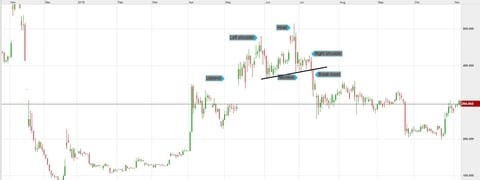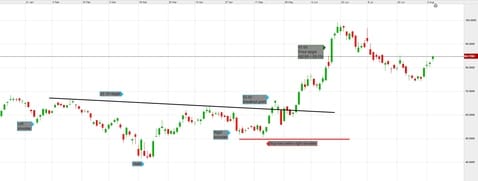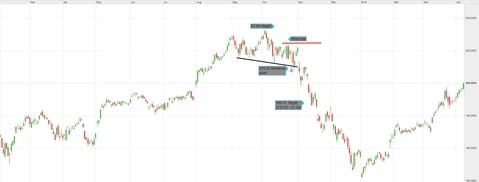Head and shoulders trading
The head and shoulders pattern is a technical formation that indicates a trend reversal is underway. For traders, it is an extremely useful pattern, whether they are trend trading and want to be alerted of potential danger or they want to catch a trend reversal near the turning point.
In this article, we explore how head and shoulders patterns can be used to identify entry and exit points for a trade, as part of technical analysis. It is important that traders learn how to spot and scan for this technical analysis pattern, and understand what it is telling you when it appears. We will also look at examples of head and shoulders trading in action during uptrends and downtrends, and how you can incorporate technical analysis into your trading strategy.
What is a head and shoulders pattern?
Head and shoulders patterns can be used to highlight price action within a wide range of markets, including forex trading, indices, cryptocurrencies and stocks. This makes it a particularly flexible and simple pattern for traders to spot on price charts.
Head and shoulders formation
When the head and shoulders pattern occurs within an uptrend, the pattern starts with the price rising and then pulling back (lower), forming the left shoulder. The price rallies again, creating a higher peak, which is known as the peak of the head. The price moves lower once again, and then rallies into a lower peak, forming the right shoulder.
When the price drops following the left shoulder and the head, these are called swing lows. Connecting the swing lows with a trendline, extended off to the right, forms a “neckline”. When the price falls below the neckline, the pattern is considered complete and the price is likely to continue moving lower.

Example of a head and shoulders pattern
Below is an example of a head and shoulders pattern that formed on a Bitcoin candlestick chart. After forming the left shoulder, head, and right shoulder, the cryptocurrency dropped through the neckline, signaling that it would continue declining.
In this case, the right shoulder is quite small. The fact the price could not bounce significantly back toward the head showed there was lots of selling pressure prior to the decline. This is what is called a head and shoulders top chart pattern.

Inverse head and shoulders pattern
An inverse head and shoulders pattern occurs in a downtrend. The price is dropping and then has a temporary rally, forming the left shoulder. The price then drops to a new low, before having another temporary rally. This forms the head. The price drops but is unable to make a new low before rallying again. This forms the right shoulder. The swing highs (rally highs) following the left shoulder and head are connected with a trend line to form the neckline. When the price breaks the neckline and moves above it, the price is likely to keep moving higher.
Here, we can see Macy’s share price declining until it forms an inverse head and shoulders pattern. There is a trend reversal to the upside when the price moves above the neckline. This is also called a head and shoulders bottom pattern.

How to draw a head and shoulders pattern
You can identify head and shoulders patterns on trading charts, whether these be candlestick or Renko charts, using various drawing tools to identify support and resistance levels and trendlines. Our online trading platform, Next Generation, has a wide range of drawing tools, price projection tools and chart types to display your positions clearly. Follow the steps below to get started:
- Open a live account to get started straight away, or practise first with virtual funds on our demo account.
- Open a live chart by selecting an instrument from the Product Library. We offer over 330 forex pairs and 8500 shares on our platform, along with other popular financial assets.
- Along the bottom of the chart, you will see several tools: Timeframe, Draw Tools, Technicals and Patterns. For head and shoulders patterns, select the Draw Tools tab.
- You now have some more options. To draw lines over the price action to better see the head and shoulder patterns, or to draw the neckline, select the Trend tool, and then click where you want the line to start and finish. Click on it again to change its settings or to move the line. This way, you can see the head and shoulder pattern more clearly.
- Also useful is the Note tool, which can also be found in the Draw Tools menu. Select it and click on the chart where you want to put a note, such as “left shoulder” or “peak of head”. This will help you to remember the head and shoulders formation.
Drawing a head and shoulders pattern with the help of our platform drawing tools helps traders to analyse the head and shoulders patterns that appear on similar price charts.
Head and shoulders trading strategy: entry, stop loss and profit target
The entry opportunity on a head and shoulders pattern occurs when the price breaks the neckline. When identifying points of entry and exit on a price chart, you should make sure that you have a sufficient risk management strategy in place. A stop-loss order is typically placed above the right shoulder for a topping pattern and is placed below the right shoulder for a bottoming pattern.
For an estimated profit target or price target, you could measure the distance of the pattern from low to high and add it to the neckline breakout point for a bottoming pattern (an inverse head and shoulders). Then, you could subtract the height of the pattern from the neckline breakout point for a topping pattern.
The height, or distance, is measured from the peak of the head to the lowest swing low within the topping pattern. If one of the swing lows was extreme (creating a very steeply angled neckline), you can use the higher swing low to generate a smaller height and therefore a more conservative price target. For a bottom pattern, the height is the bottom of the head to the top of the highest swing high within the pattern. If one of the swing highs was extreme, you can use the lower swing high that will result in less height and, again, a more conservative profit target.

Head and shoulders pattern screener
Head and shoulders patterns are tradable, providing opportunities for entry, stop loss, and profit targets. To do this, pattern recognition software can be useful for identifying head and shoulders patterns on charts. Our award-winning Next Generation platform includes a chart pattern scanner, not just for head and shoulders, but many other patterns as well, such as cup and handle and double top/bottom patterns.
While the software is useful, it should not be relied on alone. Sometimes, the software may think it recognises a set of price bars as a head and shoulders where it does not exist, or it may identify one that does not provide trading opportunities. For example, it may be too small or too large to trade, or the pattern may not be visible. Therefore, pattern recognition is a good starting point for finding patterns, but it is also a good idea to analyse the results manually to find patterns that resemble the examples shown in this guide.
Head and shoulders patterns: are they bullish or bearish?
The appearance of a head and shoulders is not initially bullish or bearish until there is a breakout. An inverse bottoming pattern could form, but until the price breaks above the neckline and keeps moving higher, the price could still be in a downtrend. If the price breaks below the pattern, that signals a continuation of the downtrend, not a reversal.
Similarly, when a topping pattern forms, this does not mean that the price will reverse. The price has to break below the neckline and keep dropping in order to confirm the reversal. If a head and shoulders forms but the price rallies above the pattern instead of dropping below it, this signals a continuation to the upside, not a reversal to the downside. To confirm which direction the price is going in, in some cases, you could wait for the neckline break.
Head and shoulders in forex
Head and shoulders patterns occur in all markets, including forex trading, and the pattern is traded in the same way. Below is an example using the major currency pair GBP/USD, with entry, stop loss and profit target opportunities marked using our online trading software.

Stocks with a head and shoulders pattern
With stocks, you can look for an uptrend where the price has formed three peaks, with the middle peak being the highest. Be sure to place a stop loss, and wait to sell or short stock until the price moves below the neckline. The default location for the stop loss is above the right shoulder, but to reduce the size of the possible loss, you could place it above any swing high that preceded the neckline breakout.
Calculate the height of the pattern, then subtract that amount from the breakout point to attain a profit target. Below is an example using the Apple stock chart, with a pattern height of 21.09. For a setup that provides a buy signal, traders should look for an inverse head and shoulders pattern, as seen in the Macy’s share example that we mentioned earlier in this article. Learn more about stock chart patterns here.

How reliable is the head and shoulders pattern?
The head and shoulders pattern can mark the end of an uptrend or downtrend, but you should wait for the price to break through the neckline before acting, as this is the point where the price reversal is often confirmed. It is typical to measure the distance or height of the pattern for an estimated profit target, use the right shoulder for stop loss placement, and the neckline for an entry point (or possibly an exit signal).
As with all advanced technical analysis patterns, there are both advantages and drawbacks when it comes to trading head and shoulders chart patterns. The profit target is an estimate, meaning that not only will the price not necessarily go that far, but it could also run much further.
Some traders will opt to focus on patterns with certain characteristics. For example, a small right shoulder means a smaller stop loss, compared with a large right shoulder. This improves the risk-to-reward ratio of the trade, because while the profit estimate is based on the entire height of the pattern, the stop loss is only based on the much smaller distance between the neckline and the right shoulder. Looking for similar characteristics can move the odds more in a trader’s favour, over multiple trades. However, on a single trade, anything can happen.

Experience our powerful online platform with pattern recognition scanner, price alerts and module linking.
- Fill in our short form and start trading
- Explore our intuitive trading platform
- Trade the markets risk-free
Disclaimer: CMC Markets is an execution-only service provider. The material (whether or not it states any opinions) is for general information purposes only, and does not take into account your personal circumstances or objectives. Nothing in this material is (or should be considered to be) financial, investment or other advice on which reliance should be placed. No opinion given in the material constitutes a recommendation by CMC Markets or the author that any particular investment, security, transaction or investment strategy is suitable for any specific person. CMC Markets does not endorse or offer opinion on the trading strategies used by the author. Their trading strategies do not guarantee any return and CMC Markets shall not be held responsible for any loss that you may incur, either directly or indirectly, arising from any investment based on any information contained herein.